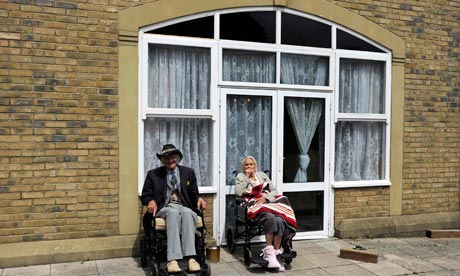Another week, another care home shocker. The family of a resident in Ash Court Care Centre in London hid a camera in a clock and allegedly caught a care worker repeatedly slapping, hitting and shouting abuse at their demented mother, with other staff joining in.
The victim was an 80-year-old former dinner lady, seen on camera crying as she was hit in the face. The family suspected something was wrong when she wept whenever they visited, but she was past explaining. Police arrested a male care worker and suspended four women at the home, run by Forest Healthcare, which owns what its website cosily calls “a family of homes” all over the country. The scandal of these end-of-life warehouses will worsen, subsisting on lower fees, banished to the margins of political concern, the cash-starved regulator cutting inspections by 70%.
Money may not guarantee kind care, but the extreme lack of it makes unkindness, neglect and sometimes cruelty almost inevitable. Labour’s record was poor: from 2004 total spending on older people’s social care rose by just 0.1% in real terms, despite growing numbers of the very old. In the same years, spending on the NHS rose by an unprecedented £25bn. AgeUK and other charities estimate that home and residential care is £3bn short of the total needed to bring it up to official minimum standards. The political imperative is always to fund the NHS, not social care – a good reason why some suggest forcing the funding together under one budget.
Cameron and Osborne claim their cuts only trim away fat from Labour’s spending years. But by no stretch of even their thin grasp on reality could they claim social care was anything but a pitifully skeletal service already. Yet in the last year councils have cut care by a devastating 8.4%, while inflation runs at 4.5%. Social care has moved from the serious to the critical list. How lucky for government that behind the secret walls of care homes, or hidden in people’s homes, neglect and cruelty stay unseen as underpaid, untrained agency staff have too little time for washing and feeding, with none at all for “care”.
Next week Andrew Dilnot publishes his report on social care. But its headline purpose touches none of the above. Its remit is to solve a problem that you might not think the most pressing of all in these straitened times – to relieve homeowners of the burden of paying so much for their nursing home care.
The coalition agreement promised a commission to “consider a range of ideas, including both a voluntary insurance system to protect the assets of those who go into residential care and a partnership scheme as proposed by Derek Wanless”. (The King’s Fund/Wanless report proposed a system of joint state and personal). In social care the most pressing political problem has often been dealing with the rage middle-aged children feel at finding their inheritance eaten away when an elderly parent has to go into care: any savings above £23,500 and the value of a property vanishes into nursing home fees. This means-testing falls hardest on those with a few savings and modest homes who lose every penny they planned to leave their heirs. It touches the richest less while penalising the thrift of small savers.
Dilnot’s reasonable proposal is to cap what anyone pays at about £50,000, with the state paying anything extra – allowing people to keep the remainder of their wealth. The hope is that on retirement people will voluntarily take out insurance to cover that £50,000, if they want to safeguard it. The state will have to pick up a bill of less than £2bn that is currently recouped through means-testing.
Oddly, yesterday’s media protested with “middle classes to pay more” stories, the exact opposite of what is proposed. Middle classes will pay less, the state will pay more, and it’s voluntary: only one in six go into care homes, so you can stay uninsured and take your chances. Dilnot sees it as restoring welfare state fairness, since fate and Alzheimer’s disease come down so heavily on some families and not on others. This builds a care payment system with public consent that will last, whatever the level of social care funding in future.
Naturally all the care charities, including AgeUK, are enthusiastic. What’s not to like in cutting bills for some? Just as naturally, the Treasury is rattling its sabre at any suggestion of paying out more: if it happens at all there will be a white paper and eventually legislation, but with no chance of implementing it until well after the next election.
Osborne is said to be concerned that this smacks of Labour’s pre-election plan for a National Care Service: Andy Burnham proposed it be paid for with a compulsory contribution of £20,000 on retirement by everyone with a property, either paid upfront or attached to the value of homes after death. It could only be kept as low as £20,000 if everyone had to pay into a pooled system. Although it, too, preserved inheritances, the Tories hammered it as Labour’s “death tax”. Mendacious but effective, the slogan worked: few voters understand the care payment system until they need it – then they are shocked to find it’s not part of the free welfare state they imagined. Even this system still won’t pay full costs, or for care at home.
This is a hot marginal constituency issue as 60,000 families a year are forced to sell parents’ homes to pay for care. But it is a sideshow compared with the real crisis. Expect Dilnot to use strong words about the state of decay in care services – but that’s beyond his remit. So is the bigger picture, where wealth is sucked up from younger generations to older ones. It may be in his remit to point out that we spend just 0.5% of GDP on social care for an ageing population. The richest generation is my own – the 55- to 64-year-olds – which has enjoyed four housing booms that poured wealth into our pockets for doing nothing at all – and now Dilnot removes the risk of losing much of it when we reach decrepitude.
So if the Dilnot plan is adopted, it should be balanced by other taxes. A mansion capital gains tax on the sale of homes sold over £1m (or less) would raise a hefty contribution to pay back some of the ill-gotten gains of my generation. Why do the over-60s pay no national insurance, however much they earn? Abolishing that would bring in £3bn, and that is enough to repair the shaming state of care.
http://www.guardian.co.uk/commentisfree/2011/jun/27/social-care-dilnot-report







